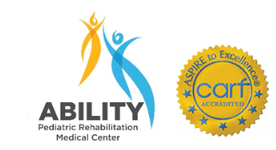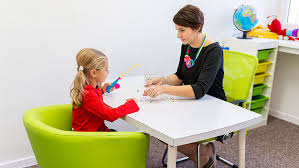Helping to add ‘easy’ to everyday tasks
Occupational Therapy Benefits:

Improve range of motion, muscle strength, muscle tone
Improve fine and gross motor abilities
Improve visual perceptual skills
Improve independence across daily life activities
Improve cognition, attention, and concentration
Improve sensory integration
Provides advice on suitable assistive devices and care giver training
Our Approach
The Occupational Therapists at Ability Pediatric Rehabilitation Medical Center help children to reach their full potential towards an assistance-free lifestyle. We cater to different levels and severity of cases, with treatments that are geared to your child's specific needs. We accomplish this by assessing their strengths and challenges to identify the most suitable program. Occupational Therapy may also help with Dyslexia, Visual Processing, Executive Functioning, and Dysgraphia.
FAQ'S
Pediatric Occupational Therapists provide treatment to help children meet developmental milestones, overcome sensory challenges, and improve self-care, play and self-regulation skills. Occupational Therapy can help your child with gross / fine motor skills, visual perception, cognition and activities of daily living.
An individualized evaluation, during which the client and therapist determine goals for treatment, customized intervention to improve the client’s ability to perform important tasks and life roles that may include hands-on-treatment, as well as modification to the client's tasks and environment to promote task performance.
Many people are unsure about the relationship between Occupational Therapy and Physiotherapy. There is often confusion about these two professions, and while there are significant differences, many grey areas where the two overlap also exist. Both Physiotherapists and Occupational Therapists are trained extensively in the anatomy of the musculoskeletal system resulting in both being knowledgeable about musculoskeletal injuries and rehabilitation. Traditionally, Occupational Therapists have focused more on evaluating and improving a person’s functional abilities while Physiotherapists focus more on problems with movement. Despite some overlap between the two, the treatment offered by both professionals is also dependent on the individual therapist’s ongoing education and training. Occupational Therapists and Physiotherapists often work collaboratively in rehabilitation settings.
Occupational Therapists are trained in the detailed mechanics of hand function as well as all other aspects that relate to the task of handwriting. The skill of handwriting requires several underlying skills before a child can effectively write. The skills that are needed for handwriting are: Body & Spatial Awareness, Laterality, Directionality, Visual Perception, Visual Motor, Integration, Postural Stability, In Hand Manipulation, Hand Separation, Hand Strength, Movement & Position Awareness, Motor Planning, Ocular Motor Control, Bilateral Integration, Eye Hand Coordination, Sensory Integration, Tactile Discrimination, Memory, Attention, Orientation to Letters, and Sequencing. It is difficult to determine the precise root cause of a handwriting problem without a thorough assessment from an Occupational Therapist.
Some signs of Sensory Processing difficulties are:
• Over sensitivity or under reactivity to sight, sounds, movement, or touch.
• Can’t get “enough” sensory input: moving, bouncing, squeezing, or mouthing.
• Difficulty with behavioral and / or emotional regulation. Easily overwhelmed (may result in overexcitement, meltdowns or shutting down.)
• Has poor muscle tone, fatigues easily, leans on people, or slumps in a chair.
• Uses an inappropriate amount of force when handling objects, coloring, writing, or interacting with siblings or pets.
• Is clumsy, falls frequently, bumps into furniture or people, and has trouble judging position of body in relation to surrounding space.
• Has difficulty learning new motor tasks; experiences frustration when attempting to follow instructions or sequence steps for an activity.
• Avoids playground activities, physical education class, and / or sports.
• Difficulty learning how to play or get along with other children.
• Difficulty with everyday activities like eating, sleeping, brushing teeth or getting dressed.
• Problems learning to color, cut, draw or write.
• Difficulty transitioning from one activity or place to another.
• Challenges in school, including attention, organizational perception and listening skills.
• Over sensitivity or under reactivity to sight, sounds, movement, or touch.
• Can’t get “enough” sensory input: moving, bouncing, squeezing, or mouthing.
• Difficulty with behavioral and / or emotional regulation. Easily overwhelmed (may result in overexcitement, meltdowns or shutting down.)
• Has poor muscle tone, fatigues easily, leans on people, or slumps in a chair.
• Uses an inappropriate amount of force when handling objects, coloring, writing, or interacting with siblings or pets.
• Is clumsy, falls frequently, bumps into furniture or people, and has trouble judging position of body in relation to surrounding space.
• Has difficulty learning new motor tasks; experiences frustration when attempting to follow instructions or sequence steps for an activity.
• Avoids playground activities, physical education class, and / or sports.
• Difficulty learning how to play or get along with other children.
• Difficulty with everyday activities like eating, sleeping, brushing teeth or getting dressed.
• Problems learning to color, cut, draw or write.
• Difficulty transitioning from one activity or place to another.
• Challenges in school, including attention, organizational perception and listening skills.
Sensory Defensiveness is a term coined by some OT’s to describe a group of over sensitivities to touch, vision, auditory, movement and smell sensations. Sensory Defensiveness is just oversensitivity to certain input. With the term defensiveness, a range of behaviors is implied. These behaviors can be observed to indicate if a sensory input is aversive.
Sensory Processing is the initial step of Sensory Integration. Inputs must be taken in, filtered, and organized before integration can occur. Integration is the final step of an organized response to inputs received. It includes a motor response typically called an adaptive response.
Occupational Therapists may provide services to children experiencing difficulty with coordination, handwriting, motor skills, or sensory processing, enabling them with better access to educational and home environments. The Therapist utilizes a variety of treatment strategies to support and facilitate motor, sensory, and perceptual development. At Ability Pediatric Rehabilitation Medical Center, we provide a one-to-one basis for the majority of the session, ending occasionally in a small group setting to promote social skills and peer interaction.
Speech Therapists (SLPs) know the ins and outs of oral motor structures and focus on the “act” of eating. If your child is having difficulty chewing / manipulating foods, keeping food in their mouth, taking a long time to chew / swallow, and / or are coughing a lot during meals, an SLP will do your evaluation. Occupational Therapists (OTs) know all things sensory. If your child is showing difficulties with specific textures, flavors, colors of foods, temperatures, etc., an OT will do your evaluation. In many cases, children with feeding issues have both oral motor and sensory difficulties.







